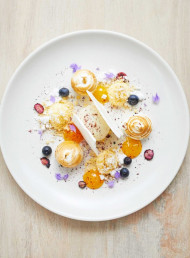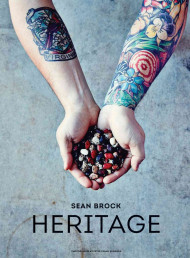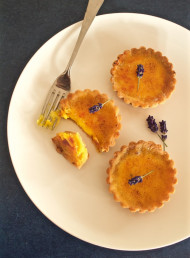Cook the Books - Saison: A Year at The French Cafe
Photography by David Parker .
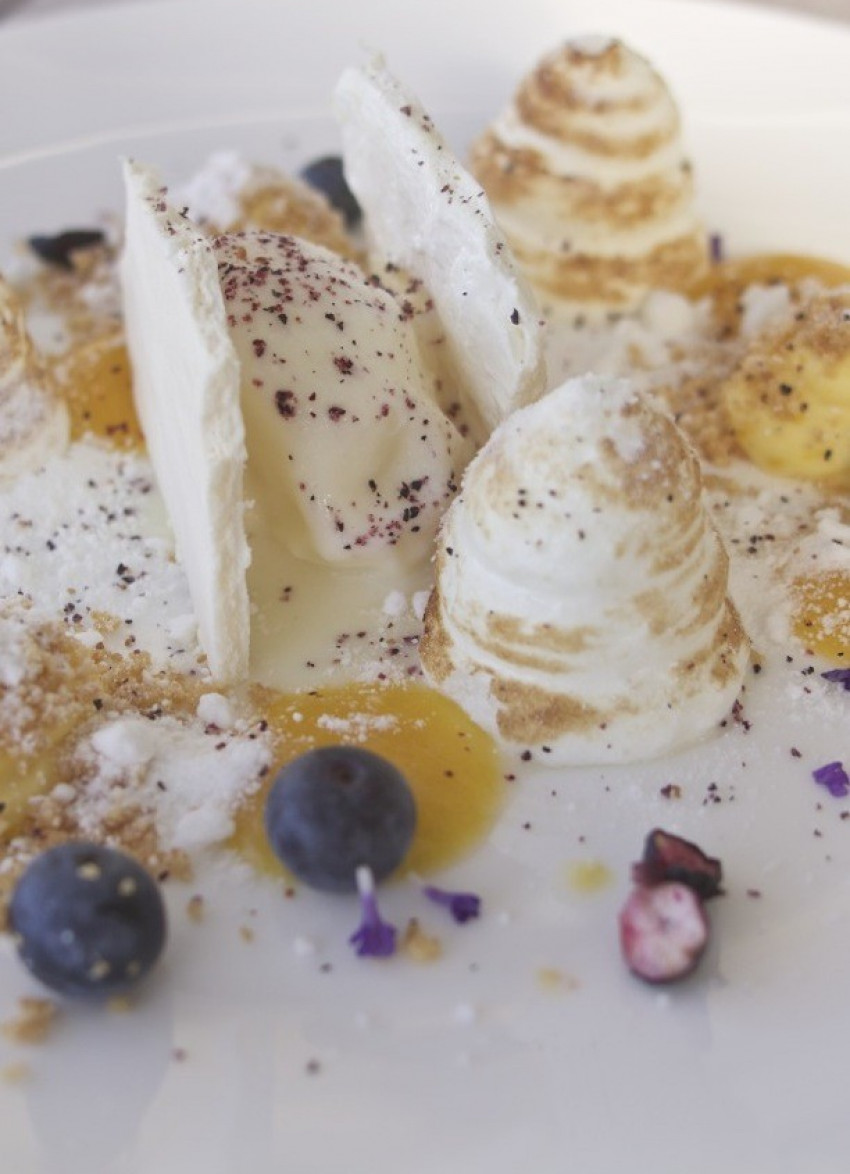
Seven hours to make a lemon meringue pie? A challenge David Parker eagerly accepted, guided by the latest cookbook from award-winning fine dining restaurant, The French Cafe.
This year I made a New Year's resolution: eat out less but at nicer restaurants. At the top of my list? The French Cafe, which is currently ranked on Trip Adviser as the fourth best restaurant in the world. IN THE WORLD. Right here in Auckland. They have an impeccable reputation for excellent food, and their second cookbook Saison: A Year at the French Café is a guide to recreating the magic at home, appealing to professional chefs and ambitious amateurs.
This was a Cook the Books challenge I was eager to accept. I dreamed of this deconstructed lemon meringue recipe for weeks. It haunted me. It kept me awake at night. I wanted to be able to do it justice. I really wanted to find all of the ingredients.
Saison is a very beautiful and well-crafted book. Mesmerizing laser cut lattice pages separate recipes by season, which is as far as the book goes in terms of a logical layout. Every page has two numbers on it, as photographs of recipes are separated from the text. I still have no idea which number refers to the page I'm on and which to the page I need to find. I have spent at least 20 minutes of my life cursing the numbering system of Saison, 20 minutes of my life I will never get back.
Almost every recipe is made up of elements that can be prepared before plating up later, often reheating at the last minute. I decided not to make the elements of this recipe in the order they are listed, attempting to align the cooking/freezing times and save myself some time. I'm not sure if I succeeded.

I started with the white chocolate sorbet, simple enough. Soften gelatin in water, heat the milk and melt in white chocolate buttons and gelatin, freeze and then process through your Pacojet machine. Wait, what? A Pacojet is a $6000 machine that micro-purées deep-frozen foods into mousses. Clearly I didn't have one of these. Fortunately if you don't have a pacojet the recipe suggests you can use an ice cream maker. I borrowed one from a friend and while it was doing its thing I got on with the pastry crumb.

I rubbed the ingredients together with my fingers into a rough crumb and spread onto a baking tray to cook. It wasn't very crumby, maybe I had combined too well?
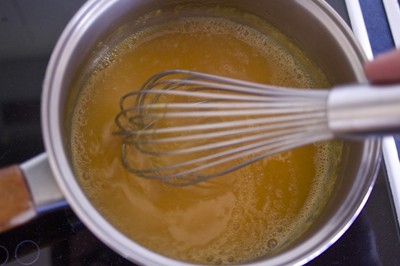
While it was cooking I boiled the passionfruit juice, sugar, water and in lieu of powdered agar I used 'Gel-it-in'. I'm not sure why gelatin wasn't used with this, but I couldn't find powdered agar anywhere. Then that went into the fridge, just in time for the crumb to come out of the oven.

I started on the meringue next. I'm familiar with an Italian meringue as it is the basis of my macaron recipe. I'm not sure why so much water is added the sugar because it took ages to boil off so the sugar can reach 120˚c. (Editor's note: If there was less water the syrup would be too thick, especially as it needs to be reheated a second time. See recipe here.)
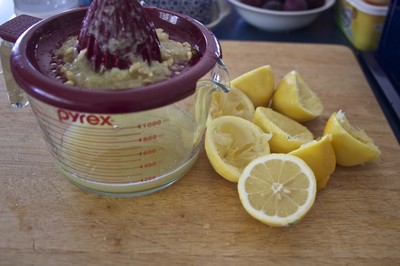
So long, in fact, that I gave up thermometer watching and sliced and juiced some lemons for the lemon curd and washed up some of the hundreds of bowls I had accumulated by this point. When it was finally near the correct temperature I got the egg whites whipped and poured in the sugar syrup when it hit 120˚C.
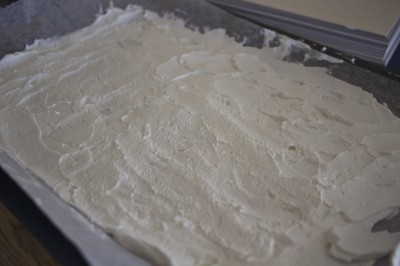
When the meringue had cooled I stopped whisking and spread a quarter of the mix onto a baking tray to go into a low oven and dry out. The rest went into a piping bag in the fridge. The sorbet was about done by this point so I put that into a tub in the freezer.
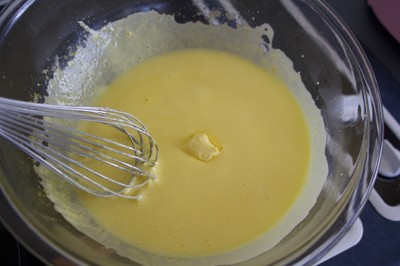
Then I got on with the lemon curd. I followed the instructions perfectly, but my lemon curd went foamy with the whisk and liquid seemed to separate from the foam while cooling. I had to get in with a spoon to break down the air bubbles and reheat until it was combined again. Very odd. I put it in the fridge to cool and it seemed to thicken properly this time.

By this point I was losing stamina, but I forged ahead blending the passionfruit jel and putting it in a squeezey bottle and back in the fridge. I got on with processing the pastry into a pastry crumb, although it was almost a shortbread in taste and texture instead of a pastry. That went into a container and then in the fridge.
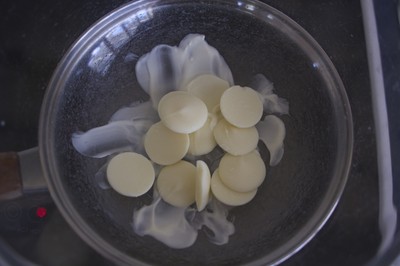
I started melting the white chocolate for the white chocolate powder. There are only two ingredients for the powder - white chocolate and maltodextrin.
Maltodextrin is a modified starch that you can powder fats with. You can make powdered olive oil with it! I could write a lot about it here as I am now the world's leading expert in maltodextrin having read everything on the internet about it. Corn-based maltodextrin can be found cheaply from most brew shops, however after my last mistake trying to buy Irish moss from a brew shop I thought better of it.
You can also buy it online in huge and expensive quantities... I decided to call straight to the source, a local importer who I'd found had it on their website at 11.50am on New Year's Eve, just before they closed for the week (yes, my holiday was WILD). Apparently you can find it at Gilmours. Alas I do not have a membership but somehow managed to sweet talk them into selling directly to me. A few failed attempts at an eftpos machine over the phone and a few emails later I had a 500 gram bag on my way the next Monday.
I blended the maltodextrin and added melted white chocolate until they came together in a mysteriously sweet powder.

Then I picked some lavender tips from the garden. They weren't exactly the same variety of lavender as in the photo but I think I got away with it. I broke the dried out meringue into shards, and finally whipped cream to a 'soft whip' and combined it with the lemon curd in a piping bag ready to assemble the dish.
First I piped 3 mounds of lemon meringue and lightly browned them with a blow torch (the meringue having being cooked when the hot sugar was added to the egg yolks) then 3 mounds of the lemon curd cream, a sprinkling of crumb and a few drops of the passionfruit gel around the plate.
The recipe says to sprinkle the meringue with white chocolate powder but the photo it looks like it's on top of the crumb on the lemon curd mounds, so I sprinkled a little on the meringues and more on the lemon curds. Then I scattered a few blueberries around the plate and freeze dried blueberries (I managed to find them in a supermarket would you believe).
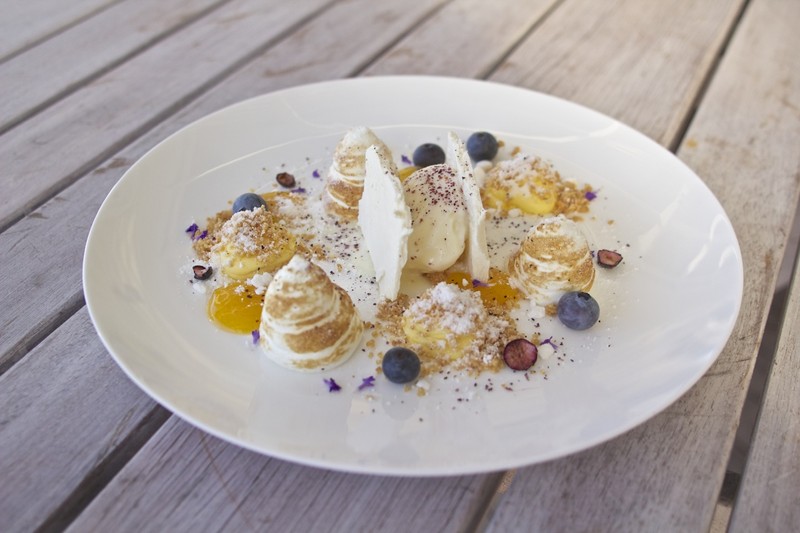
I then carefully spooned in the white chocolate sorbet and balanced a couple of pieces of the meringue against it before sprinkling the whole thing with ground up freeze-dried blueberries, the recipe didn't say to do this but I could see it had been done.
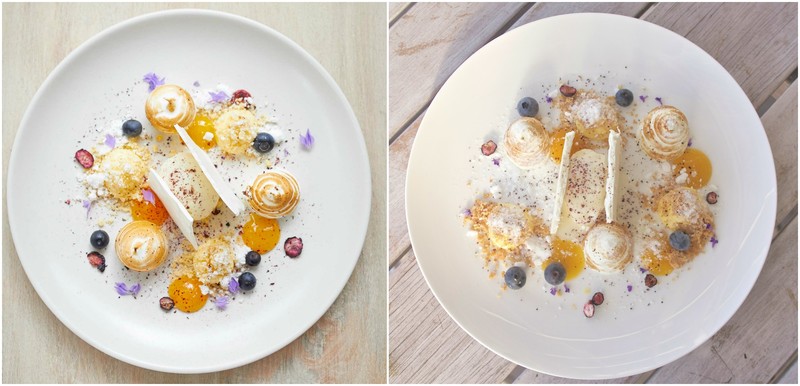
The French Cafe's version (left) photographed by Charlie Smith, compared to David's (right).
It is a beautifully balanced dish; alone the passionfruit gel seemed too intense and the sorbet too subtle, but together they all balance out. You can taste all the flavours and there are so many textures. The blueberries bring a burst of freshness and the powder and crumb tie everything together. The meringue is surprisingly lemony and fragrant - I felt weird about eating the soft meringue but when I got some on my spoon it was like an incredibly light lemony mousse. I really wanted to get this right and make something worthy of being served at the French Cafe, I'm not sure I'll be getting any michelin stars anytime soon but this was amazingly good.
latest issue:
Issue #120
As the days become shorter, and the nights cooler, the latest issue is perfectly timed to deliver delicious autumn dishes. From recipes using fresh seasonal produce such as feijoas and apples, to spectacular soothing soups and super-quick after-work meals in our Food Fast section, we’ve got you covered. With Easter on the horizon, we feature recipes that will see you through breakfast, lunch and dinner over a leisurely weekend holiday, and whip up chocolatey baking treats sure to please. We round up delicious dinners for two and showcase a hot new Korean cookbook before heading south to Dunedin to check out all that’s new in food and dining.The latest issue of dish is on sale NOW at all good bookstores and supermarkets – don’t miss it!


